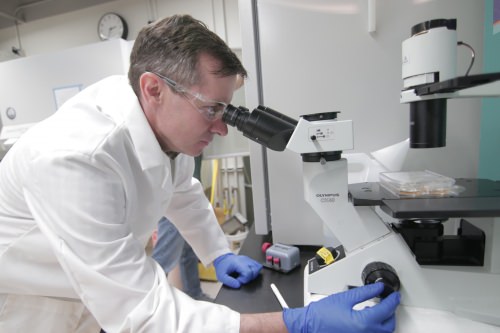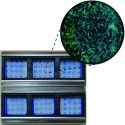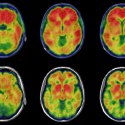UW–Madison to partner in $20 million cell-based therapy center
The National Science Foundation has awarded nearly $20 million to a consortium of universities, including the University of Wisconsin–Madison, to support a new engineering research center that will develop transformative tools and technologies for the consistent, scalable and low-cost production of high-quality living therapeutic cells. Such cells could be used in a broad range of life-saving medical therapies now emerging from research laboratories.
The new NSF Engineering Research Center for Cell Manufacturing Technologies (CMaT) will be led by the Georgia Institute of Technology. Working closely with industry and clinical partners, CMaT could help revolutionize the treatment of cancer, heart disease, autoimmune diseases and other disorders.
UW–Madison was selected as a major partner in CMaT, a consequence of the university’s pioneering efforts in stem cell engineering and a long history of collaboration between its College of Engineering and School of Medicine and Public Health, says Sean Palecek, professor in chemical and biological engineering and CMaT’s associate director for research. Additional partners include the University of Georgia and the University of Puerto Rico, Mayagüez campus.

UW-Madison professor Sean Palecek is the associate director for research of the newly funded NSF Engineering Research Center for Cell Manufacturing Technologies (CMaT). Photo: Stephanie Precourt
The UW–Madison team includes professors of biomedical engineering William Murphy, Randolph Ashton and Krishanu Saha; cardiology Professor Timothy Kamp; medical history and bioethics Professor Linda Hogle; and Mary Fitzpatrick, director of diversity research and initiatives for the College of Engineering.
The UW–Madison researchers will focus on two disease applications: induced pluripotent stem cells for making heart muscle, and engineered T cells to combat cancer.
In July, the Food and Drug Administration’s Oncologic Drugs Advisory Committee endorsed the use of T cells, a type of immune cells in the blood, for treating certain types of blood cancer.
“Engineering the patient’s own T cells to recognize and kill tumor cells is one of the new frontiers in cancer research,” says Palecek. “But more work is needed to prevent a massive immune response in the patients who receive these modified T cells, and to learn how this type of therapy may eventually be applied to solid tumors as well.”
To realize the promise of stem-cell-derived heart muscle cells for survivors of a heart attack, who typically lose about 25 percent of their pump’s muscle mass, researchers need to go from making millions of cells to billions while ensuring uniformly high quality.
“Cell therapy is today where biotechnology was in the 1980s,” Palecek says. “It is a field with a ton of promise that we know will be big. But since we don’t yet have a cure for anything, we need to make plans for a manufacturing process while we don’t exactly know yet the specific cell type we’re going to manufacture.”
To help with that tall order, CMaT will rely on the combined expertise of UW–Madison’s Stem Cell and Regenerative Medicine Center — co-directed by Murphy and Kamp — and the resources of Waisman Biomanufacturing, a cell and gene product development facility at UW–Madison’s Waisman Center.
“UW-Madison is one of just a handful of places in the world that has this kind of biomanufacturing capability right here on campus, allowing for a much faster translation of lab research findings to the clinic,” Palecek says.
Working closely with industry and clinical partners, CMaT could help revolutionize the treatment of cancer, heart disease, autoimmune diseases and other disorders.
Waisman Biomanufacturing, along with Madison Area Technical College (Madison College) and an already formed CMaT industry consortium, will be critical partners in workforce development, since the fast-growing cell therapy industry will need many more people with specialized training, especially at the community college level.
Madison College is ahead of the curve with an existing stem cell certificate program and, with CMaT support, will further refine the skills taught through this program and help establish similar training opportunities throughout the country. UW–Madison’s Fitzpatrick will co-direct center research on inclusivity impacts on manufacturing.
Palecek says building a community of people with different levels of training and career paths, but similar overall interests, is one of the biggest benefits of a large-scale project like CMaT.
“The opportunity for collaboration across multiple disciplines and institutions is very exciting,” he says. “In addition, our regular interactions with companies that are on the front line of making these cells mean that they may sponsor additional research efforts and offer internships to our students, ensuring that this kind of public-private partnership will truly be win-win for everybody.”
Tags: research, stem cells



